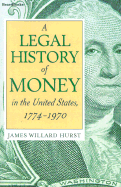|
|
|
|
||||||

|
A Legal History of Money:
In the United States 1774-1970 By James Willard Hurst 2001/06 - Beard Books 1587980983 - Paperback - Reprint - 385 pp. US$34.95 Fascinating reading for those interested in the cause and effect relations between legal processes and economic processes and those concerned with separation of powers and public administration. Publisher Comments
This book deals with the legal elements of the system of money from about 1774 to 1970, examining the benefits and detriments to that system from legal interventions. The Legal History of Money in the United States focuses on two main concerns: the determination of the legitimate purposes for which we might use law to affect the money supply and the allocation of legal authority affecting the money supply among different agencies. Review by Gail Owens Hoelscher This book chronicles the legal elements of the history of the system of money in the United States from 1774 to 1970. It originated as a series of lectures given by James Hurst at the University of Nebraska in 1973. Mr. Hurst is quick to say that he , as a historian of the law, took care in this book not to make his own judgments on matters outside the law. Rather, he conducted an exhaustive literature review of economics, economic history, and banking to recount the development of law over the operations of money. He attempted to "borrow the opinions of qualified specialists outside the law in order to provide a meaningful context in which to appraise what the law has done or failed to do." Mr. Hurst define money, for the purposes of this books, as "a distinct institutional instrument employed primarily in allocating scarce economic resources, mainly through government and market processes," and not shorthand for economic, social, or political power held through command of economic assets." From the beginning, public and legal policy in the U.S. centered on the definition of legitimate uses of both law affecting money, and allocation of power over money among official agencies, both federal and state. The foundations of monetary policy were laid between 1774 and 1788. Initially, individual state legislatures and the Continental Congress issued paper currency in the form of bills of credit. The Constitutional Convention later determined that ultimate control of the money supply should be at the federal level. Other issues were not clearly defined and were left to be determined by events. The author describes how law was used to create and maintain a system of money capable of servicing the flow of resource allocations in an economy of broadly dispersed public and private decision making. Law defined standard money units and made those units acceptable for use in conducting transactions. Over time, adjustment of the money supply was recognized as a legitimate concern of law. Private banks were delegated expansive monetary action powers throughout the 1900s and private markets for gold and silver were allowed to affect the money supply until 1933-34. Although the Federal Reserve Act was not aimed clearly at managing money for goals of major economic adjustment, it set precedents by devaluing the dollar and restricting the use of gold. Mr. Hurst devotes a large part of his book to key issues of monetary policy involving the distribution of power over money between the nation and the states, between legal and market processes, and among major agencies of the government. Until about 1860, all major branches of government shared in making monetary policy, with states playing a large role. Between 1908 and 1970, monetary policy became firmly centralized at the national level, and separation or powers questions arose between the Federal Reserve Board, the White House (The Council of Economic Advisors), and the Treasury. The book was an enormous undertaking and its research exhaustive. It includes 18 pages of sources cited and 90 pages of footnotes. Each era of American legal history is treated comprehensively. The book makes fascinating reading for those interested in the cause and effect relationship between legal processes and economic processes and those concerned with public administration and the separation of powers.
|
|
|
|
home
| about us
| contact us
| related
sites |